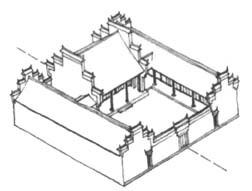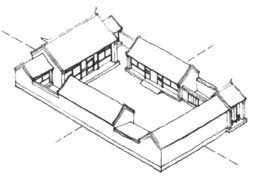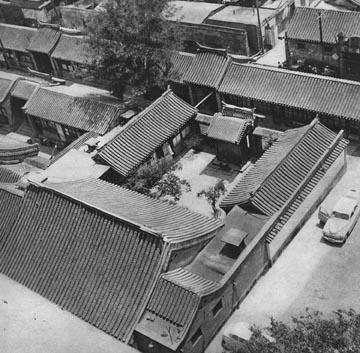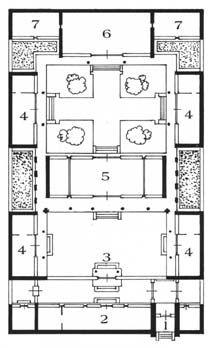I like these: http://depts.washington.edu/chinaciv/home/3intrhme.htm
Guys, the courtyard plan is as old as history itself.
It's not exclusive of the chinese. First examples were found in Mesopotamia 10.000 years ago where later cities like Ur, Uruk, and Babilonia were founded.
The basic courtyard design of succesion of courtyard cells became popular and can be found all over the world. From middle east, to Asia, Europe, Colonial and precolonial America.
Take a look. The idea isn't too actually replicate these,but adapt these to the style you like the most.
Generally speaking these types of construction aren't cheap, but a three-sided courtyard house is cheaper, and a two sided one can be made as well, using a basic L shaped house plan.





Uses of rooms in a typical two-courtyard house plan at left:
1. Main entrance
2. Rooms facing the rear. The rooms facing the back, those near the entrance to the courtyard were reserved for the servants if the family was well-off.
3. First courtyard. Cooking was carried out here, and the second courtyard was a living space.
4. East and west-side rooms, for the sons and daughters, or the sons' families.
5. Inner Hall. Where the members of the family greeted guests or where family ceremonies were held.
6. Main building. Living space for parents.
7. Small side rooms. These used for children and extended family members.
Edited to add: Changing the house ins't a possibility ofr most, but a perimeter wall is realtively simple to build and provides much better security.
FerFAL








3 comments:
Hey Ferfal, long time reader here & first time poster, from California. Great job you do with your advice! I actually made my own altoids can kit & keep it in my car now, with a few other items. :-)
Regarding the 3-sided courtyard house, I like the concept and think it works well overall. Some may prefer a different style but this design is not bad, as it places function over form.
A modern revision might be to add a garage somewhere. Perhaps trading one of the side structures for a driveway, with a 2-car garage in a rear corner. If an alley exists behind the house, then having double doors (front & back) on the garage so vehicles can access both sides of the property could have value, just in case. Design is all tradeoff's.
Depending on land prices & budget, a thin path around the edges & inside a fence, rather than building to the lot line, would help for fire access, maintenance and letting a dog roam to investigate.
Anyway, I know you can't get it all in one post, but just wanted to add some helpful hints. I sketch 10 house floorplans per week appraising real estate, so I think about this stuff more than most.
Take care & keep up the great work! I read your blog several times a week.
Absolutely Luke, you can make one of the sides into the garage, and complete with an L shaped house plan and a access wall.
The important thing is to have a solid exteriror wall, either cement blocks reinforced with rebar or poured concrete.
Here's were architecture makes the difference, you can end up with either a prison or a very good looking place.
I'm in the Architecure business as well, hopefully getting my Architect degree soon, and this issue of integrating security into the architectural desgin would require a couple books on its own.:)
FerFAL
Hey FerFAL...Gaucho of the Glock!
Courtyard houses were not only built because of security reasons, but also to hide from the eyes of the tax collector. In south China a rich rice merchant would build a plain exterior, but inside have lots of fine art and servants and so on.
I got to stay in a real one in "East Turkistan." Inside was a well, an open latrine, and also the family cow. At night we shut the outer door which was big enough to drive a car through, then the doors to the house. Seems that the neighborhood had informants that would tell the police that a foreigner was here. The police then would hassle my hosts.
I like the design, but I want to add a moat. Someone creative could make it seem decorative, not defensive.
Post a Comment